The MEIA-W-R (Multidimensional Emotional Intelligence Assessment – Workplace – Revised) defines emotional intelligence as a willingness to perceive, understand, and regulate emotions in the self and in others. The MEIA-W-R measures 11 distinct aspects of EI as expressed in the workplace.
This report presents your MEIA-W-R results. It describes your scores on each of the 11 MEIA-W-R dimensions. This includes your relative score compared to the norm sample and a more in-depth explanation of each MEIA-W-R dimension. Because each dimension has workplace performance and development implications, the report also includes development advice.
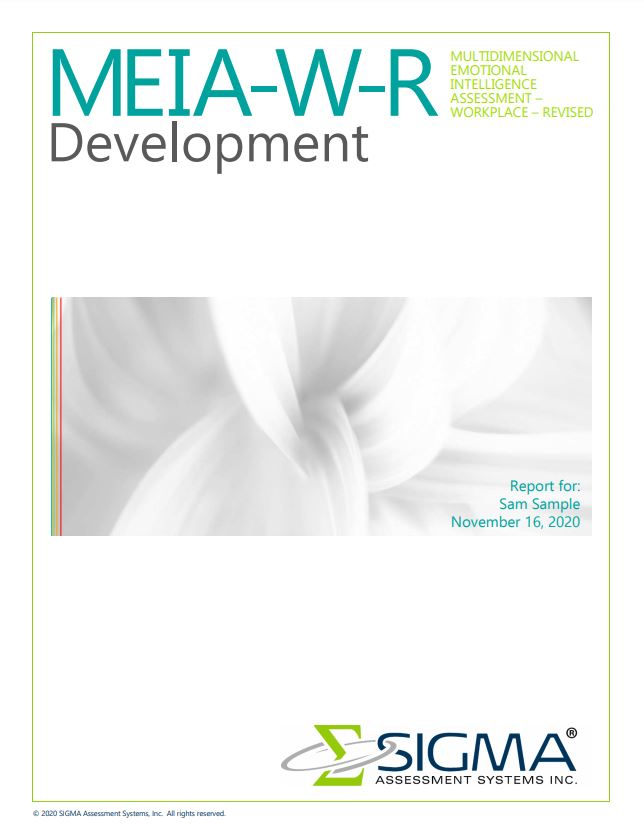
MEIA-W-R Report Contents
- Page 4 – Interpreting the Report
- Page 5 – The MEIA-W-R Approach
- Page 6 – MEIA-W-R Results
- Page 10 – MEIA-W-R Dimension-by-Dimension Results
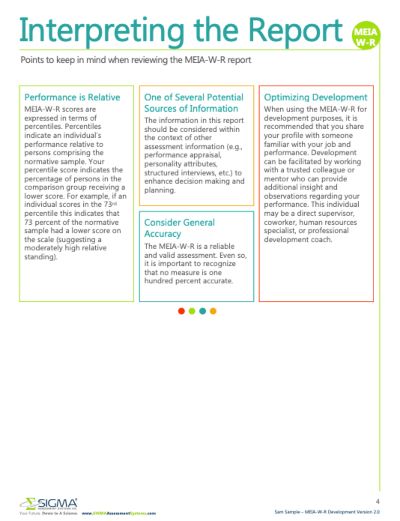
There are several points to keep in mind when reviewing your MEIA-W-R report, including:
- Performance is Relative. MEIA-W-R scores are expressed in terms of percentiles. Percentiles indicate an individual’s performance relative to persons comprising the normative sample. Your percentile score indicates the percentage of persons in the comparison group receiving a lower score. For example, if an individual scores in the 73rd percentile this indicates that 73 percent of the normative sample had a lower score on the scale (suggesting a moderately high relative standing).
- One of Several Potential Sources of Information. The information in this report should be considered within the context of other assessment information (e.g., performance appraisal, personality attributes, structured interviews, etc.) to enhance decision making and planning.
- Consider General Accuracy. The MEIA-W-R is a reliable and valid assessment. Even so, it is important to recognize that no measure is one hundred percent accurate.
- Optimizing Development. When using the MEIA-W-R for development purposes, it is recommended that you share your profile with someone familiar with your job and performance. Development can be facilitated by working with a trusted colleague or mentor who can provide additional insight and observations regarding your performance. This individual may be a direct supervisor, coworker, human resources specialist, or professional development coach.
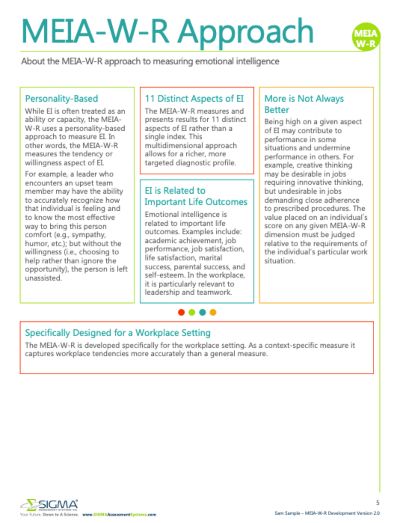
When utilizing the MEIA-W-R, it’s important to understand its approach:
- The MEIA-W-R is personality-based. While EI is often treated as an ability or capacity, the MEIAW-R uses a personality-based approach to measure EI. In other words, the MEIA-W-R measures the tendency or willingness aspect of EI. For example, a leader who encounters an upset team member may have the ability to accurately recognize how that individual is feeling and to know the most effective way to bring this person comfort (e.g., sympathy, humor, etc.); but without the willingness (i.e., choosing to help rather than ignore the opportunity), the person is left unassisted.
- It uses 11 distinct aspects of EI. The MEIA-W-R measures and presents results for 11 distinct aspects of EI rather than a single index. This multidimensional approach allows for a richer, more targeted diagnostic profile.
- EI is related to important life outcomes. Emotional intelligence is related to important life outcomes. Examples include: academic achievement, job performance, job satisfaction, life satisfaction, marital success, parental success, and self-esteem. In the workplace, it is particularly relevant to leadership and teamwork.
- More is not always better. Being high on a given aspect of EI may contribute to performance in some situations and undermine performance in others. For example, creative thinking may be desirable in jobs requiring innovative thinking, but undesirable in jobs demanding close adherence to prescribed procedures. The value placed on an individual’s score on any given MEIA-W-R dimension must be judged relative to the requirements of the individual’s particular work situation.
- It’s specifically designed for a workplace setting. The MEIA-W-R is developed specifically for the workplace setting. As a context-specific measure it captures workplace tendencies more accurately than a general measure.
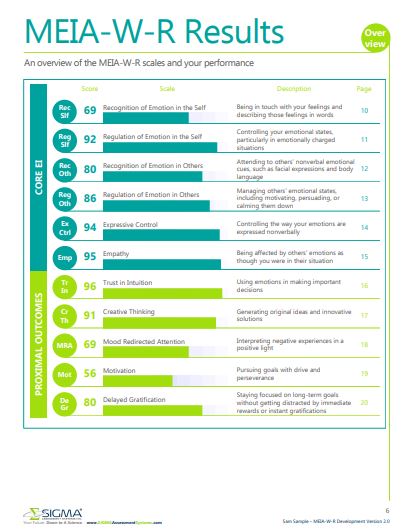
This section of the MEIA-W-R provides an overview of the assessment’s dimensions as well as your results.
Table provides an overview of the MEIA-W-R scores, scales, and your performance.
These scores can be interpreted according to the following index:

- Develop behaviors. Weak to low tendency. Develop awareness and understanding of behaviors related to the dimension. Begin practicing behaviors or increase utilization of behaviors. Observe impact of behaviors on positive or desired outcomes.
- Enhance application of behaviors. Moderate tendency. Strengthen tendency and develop more consistent behaviors. Stay vigilant for situations and opportunities to apply behaviors.
- Refine application of behaviors. Strong to high tendency. Refine behaviors to achieve desired outcomes. Monitor and adjust tendency to match situation. Work on refining or optimizing behaviors according to context. Apply knowledge to influence others’ appreciation and application of emotional intelligence.
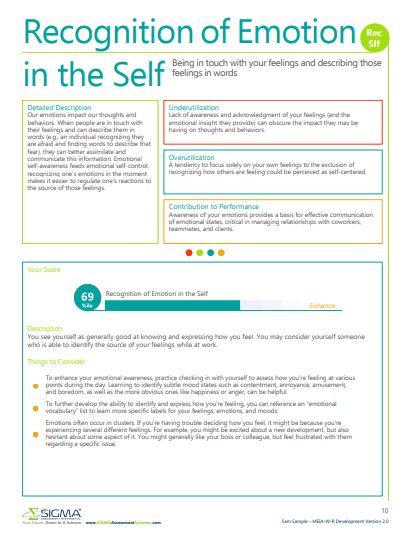
This section of the report will provide you with a closer look at each MEIA-W-R dimension and your results. The MEIA-W-R Dimensions discussed include:
- Recognition of Emotion in the Self – Being in touch with your feelings and describing those feelings in words.
- Regulation of Emotion in the Self – Controlling your emotional states, particularly in emotionally charged situations.
- Recognition of Emotion in Others – Attending to others’ nonverbal emotional cues, such as facial expressions and body language.
- Regulation of Emotion in Others – Managing others’ emotional states, including motivating, persuading, or calming them down.
- Expressive Control – Controlling the way your emotions are expressed nonverbally
- Empathy – Being affected by others’ emotions as though you were in their situation
- Trust in Intuition – Using emotions in making important decisions
- Creative Thinking – Generating original ideas and innovative solutions
- Mood Redirected Attention – Interpreting negative experiences in a positive light
- Motivation – Pursuing goals with drive and perseverance
- Delayed Gratification – Staying focused on long-term goals without getting distracted by immediate rewards or instant gratifications
Determine Your Team’s EI with the MEIA-W-R Assessment
To gain access to a customized version of this report and more, order the MEIA-W-R assessment online today or contact us to find out more about our leadership development assessments.